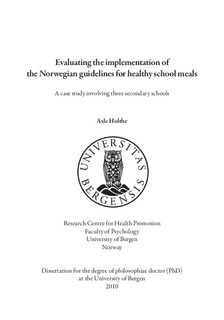| dc.description.abstract | Introduction Healthy eating is an important factor in children’s health and academic performance. Children and adolescents eat at least one daily meal at school and school meals represent a considerable part of their overall diet. Therefore, governments are encouraged to adopt policies that support healthy diets at school and that limit the availability of products high in salt, sugar, and fats. As part of the national policy on diet and nutrition, the Norwegian Directorate for Health and Social Affairs published guidelines in 2003 for healthy school meals in primary and secondary schools. The overall aim of this study was to evaluate the implementation of the Norwegian guidelines for healthy school meals in three secondary schools, with a specific focus on how individual and organizational factors interacted with and influenced this implementation. Methods This study was based on a multiple-case design with an exploratory approach. Data were collected at three secondary schools in Norway that had participated in the intervention project Physical activity and healthy school meals. A comprehensive approach to the sources of data was chosen, and the sources consisted of baseline questionnaires, observations, interviews, and documents. Individual interviews were conducted with school principals and project leaders, and focus group interviews were conducted separately with teachers and students. The data were analysed using a case-oriented strategy (Miles & Huberman, 1994) and a variable-oriented strategy (Miles & Huberman, 1994). 3 Results Paper 1 describes the degree of implementation achieved in terms of adherence, exposure, quality of delivery, and weekly revenue. The factor that was most important for the implementation of the guidelines was the construction of an innovation-specific organizational capacity through an organizational infrastructure, particularly by the allocation of financial and human resources, the adjustment of food and beverages available and strong leadership support. Paper 2 reports the barriers to the implementation of the national guidelines for healthy school meals as perceived by the principals, project leaders, teachers, and students. Four categories of barriers were identified: (1) the lack of adaptation of the guidelines to the target group, (2) the lack of resources and funding, (3) conflicting values and goals, and (4) access to unhealthy food outside the school. These findings suggest that there are differences in the barriers perceived by the staff, who are responsible for the implementation of the intervention, and the students, who are the target group. Paper 3 reports how physical structures, represented by (i) the type of consumer products, (ii) the availability of facilities in the school buildings, and (iii) the students’ access to neighbourhood facilities, contributed to the availability of food and beverages consistent with the national guidelines. The findings suggest that the degree of implementation was influenced by the type of consumer products available, the facilities in the school buildings, and the regulation of access to neighbourhood facilities. A lack of adequate canteen facilities influenced the selection of food on offer, food safety, and capacity. Conclusion This thesis shows that implementation is a complex process, which influenced the extent to which three schools met the Norwegian national guidelines for healthy school meals. The findings suggest that the schools’ intentions regarding the implementation of the guidelines 4 were mainly focused on enabling factors, such as the allocation of resources, the adjustment of the food and beverages offered to accommodate the available resources and infrastructure, changes in the school timetable, and the provision of leadership support. There was less focus on predisposing and reinforcing factors at the school level. The findings also indicate that the schools focused on implementing the essential features of the national guidelines that suited their needs. However, the selection of elements from the guidelines upon which to focus affected the degree of their implementation. The national guidelines represent a national policy aimed at changing institutional factors at the school level. The findings of this study suggest that the lack of canteen facilities, funding, and competence limited the schools’ ability to deliver a quality service and were barriers to the successful implementation of the guidelines. Furthermore, implementing the guidelines drew time away from the core business of schooling. The schools’ role in health promotion is a statement of the national school policy. However, these findings indicate that healthy school meals are not regarded by the staff as an obvious responsibility of schools, nor were the schools resourced to fulfil their role in the delivery of healthy school meals. Implications This study has several implications for practice and research. The findings suggest that principals must use both leadership and management strategies to address the teachers’ predisposing, reinforcing, and enabling factors. The implementation of the intervention in schools focused on changing the school organization rather than the individuals involved, and therefore the schools are recommended to actively adopt a whole-school approach. To reduce the barriers to students’ healthy eating, it may be beneficial to give stronger focus on accommodating the students’ needs and preferences by increasing the availability and 5 accessibility of healthy food. Cooperation with municipal kitchens or private food enterprises could allow schools to offer more-attractive healthy school meals with high standards of food safety. The national authorities are encouraged to revise the national guidelines for healthy school meals to make them a stronger and more influential policy document by including implementation guidelines. Further research is required to optimize the implementation process. | en_GB |
| dc.relation.haspart | Paper II: Maternal and Child Nutrition 7(3), Holthe, A.; Larsen, T.; Samdal, O., Understanding barriers to implementing the Norwegian national guidelines for healthy school meals: a case study involving three secondary schools, pp. 315-327. Copyright 2010 Blackwell Publishing. Full text not available in BORA due to publisher restrictions. The published version is available at: http://dx.doi.org/10.1111/j.1740-8709.2009.00239.x | |
| dc.relation.haspart | Paper III: Health & Place 16(1), Holthe, A.; Larsen, T.; Samdal, O., The role of physical structures in implementing the Norwegian guidelines for healthy school meals, pp. 93–100. Copyright 2009 Elsevier. Full text not available in BORA due to publisher restrictions. The published version is available at: http://dx.doi.org/10.1016/j.healthplace.2009.09.001 | |


